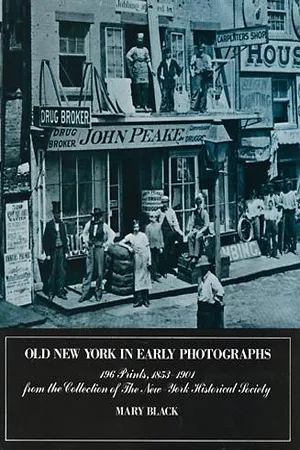
- 228 pages
- English
- ePUB (mobile friendly)
- Available on iOS & Android
eBook - ePub
Old New York in Early Photographs
About this book
New York City as it was 1853-1901, through 196 wonderful photographs: great blizzard, Lincoln's funeral procession, great buildings, much more.
Frequently asked questions
Yes, you can cancel anytime from the Subscription tab in your account settings on the Perlego website. Your subscription will stay active until the end of your current billing period. Learn how to cancel your subscription.
At the moment all of our mobile-responsive ePub books are available to download via the app. Most of our PDFs are also available to download and we're working on making the final remaining ones downloadable now. Learn more here.
Perlego offers two plans: Essential and Complete
- Essential is ideal for learners and professionals who enjoy exploring a wide range of subjects. Access the Essential Library with 800,000+ trusted titles and best-sellers across business, personal growth, and the humanities. Includes unlimited reading time and Standard Read Aloud voice.
- Complete: Perfect for advanced learners and researchers needing full, unrestricted access. Unlock 1.4M+ books across hundreds of subjects, including academic and specialized titles. The Complete Plan also includes advanced features like Premium Read Aloud and Research Assistant.
We are an online textbook subscription service, where you can get access to an entire online library for less than the price of a single book per month. With over 1 million books across 1000+ topics, we’ve got you covered! Learn more here.
Look out for the read-aloud symbol on your next book to see if you can listen to it. The read-aloud tool reads text aloud for you, highlighting the text as it is being read. You can pause it, speed it up and slow it down. Learn more here.
Yes! You can use the Perlego app on both iOS or Android devices to read anytime, anywhere — even offline. Perfect for commutes or when you’re on the go.
Please note we cannot support devices running on iOS 13 and Android 7 or earlier. Learn more about using the app.
Please note we cannot support devices running on iOS 13 and Android 7 or earlier. Learn more about using the app.
Yes, you can access Old New York in Early Photographs by Mary Black in PDF and/or ePUB format, as well as other popular books in Art & Histoire de l'Amérique du Nord. We have over one million books available in our catalogue for you to explore.
Information
Topic
ArtSubtopic
Histoire de l'Amérique du NordI
THE BATTERY AND THE EAST RIVER WATERFRONT
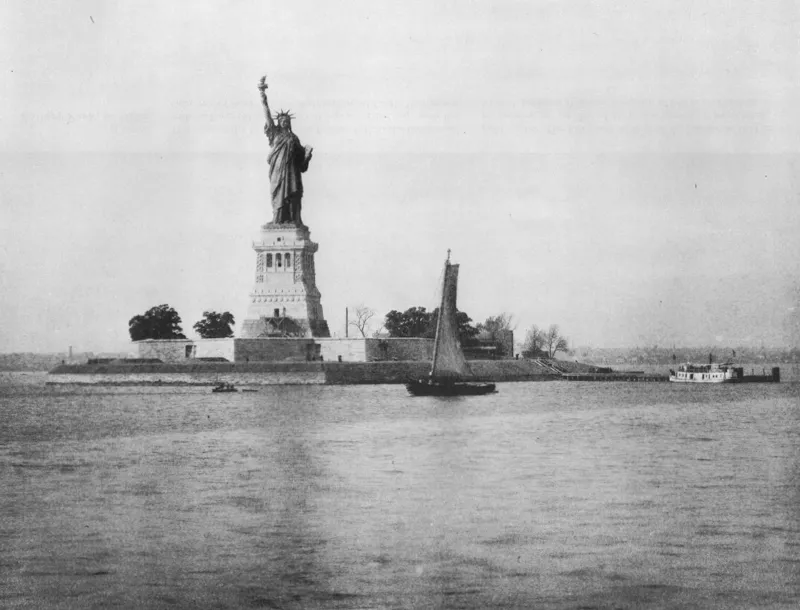
Photo, Edward Bierstadt
[PLATE 1]
Liberty Enlightening the World,
c. 1886
Liberty Enlightening the World,
c. 1886
This shimmering view of the lady in the harbor was issued inquantity by Artotype, Bierstadt’s name for the multiple-printphotoprocess he used. Edward Bierstadt, who was a printer aswell as a photographer, was the brother of the celebrated landscape artist Albert Bierstadt. This print, presented to the Society in 1890, probably records the appearance of the figure shortly after it was dedicated in 1886.
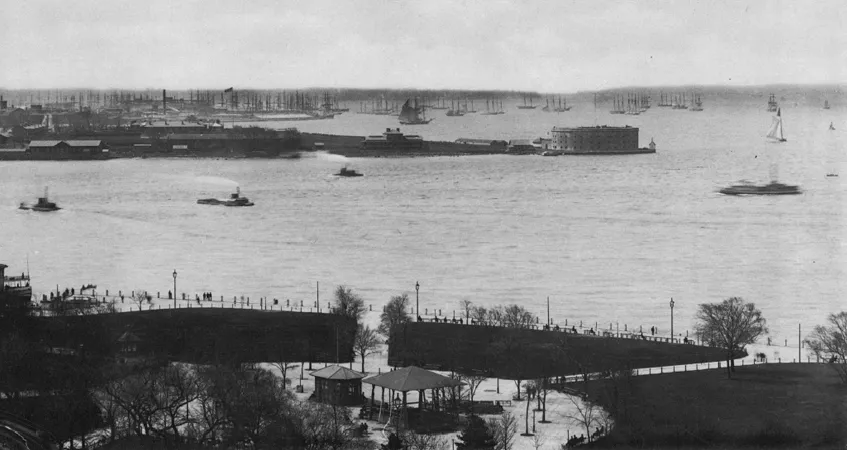
[PLATE 2]
Battery Park, c-1885
Battery Park, c-1885
This view of the harbor shows Battery Park in the foreground with the Barge Office at the left. Before a forest of ship masts lies Governor’s Island with the fortifications of Castle Williams at right center. The fort, built to defend the harbor in 1811 in preparation for the War of 1812, was named for its architect, Lt. Col. Jonathan Williams, a nephew of Benjamin Franklin.
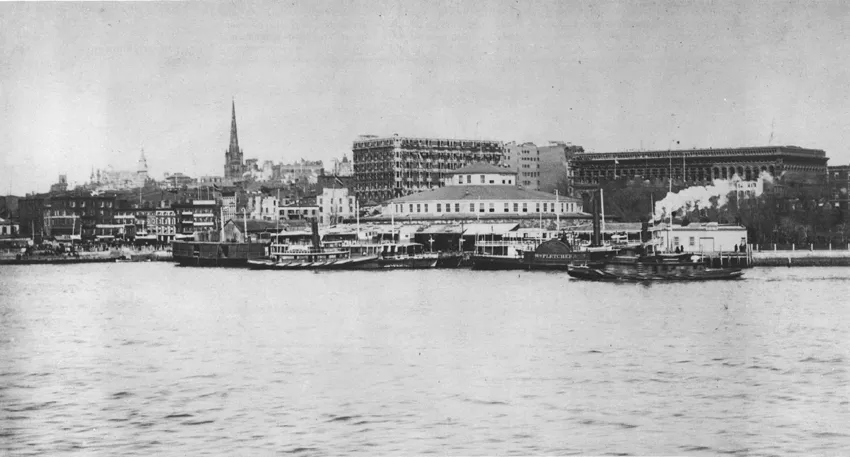
[PLATE 3]
Skyline at the Battery, 1883
Skyline at the Battery, 1883
Visible in this late nineteenth-century photograph of the Manhattan skyline are (from left to right) the Western Union Telegraph Building, Trinity’s steeple, the Washington Building, Castle Garden, and the Produce Exchange. Castle Garden, earlier called Castle Clinton, was built c. 1807; from the 1820s to the 1850s it was an important theater and assembly hall; from 1855 to 1890 it was New York’s immigrant station; from 1896 to 1942 it housed the New York Aquarium. Today it resembles the fort as it was originally built. (The side-wheeler William Fletcher was out of Boston.)

[PLATE 4]
Bowling Green, 1898
Bowling Green, 1898
This view, taken from a high window on the east side of lower Broadway, shows Bowling Green, New York City’s first park, as it appeared about 100 years after it was enclosed by the fence seen here. The buildings at the left are part of Steamship Row, and Battery Park appears in the distance. Broadway begins at the right, the second building, 7-11 Broadway, having been completed the year this picture was taken. Designed by W. G. Audsley, its impressive Egyptian Revival facade incorporates ancient pillars into the design of the entrances. The recruiting tent in the foreground and the bare branches on the trees set the photograph date to the start of the Spanish-American War (declared April 25th). Dimly seen at the end of the park is the seated figure of Abraham de Peyster by George Edwin Bissell, installed just two years before near the spot where the equestrian statue of George III was torn down by an irate populace on July 9, 1776.
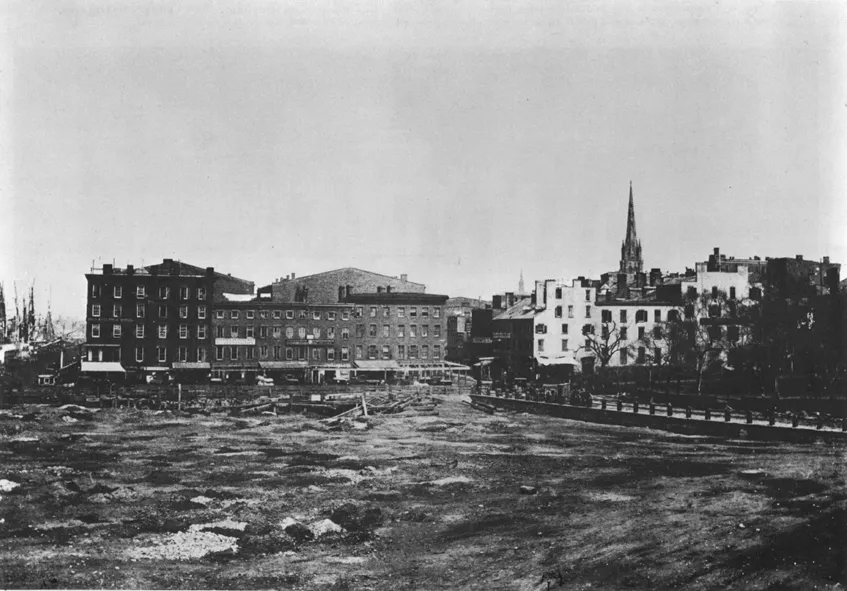
Photo Victor Prevost
[PLATE 5]
Battery Place, 1853
Battery Place, 1853
This early view looking north from Battery Place was taken by the French photographer Victor Prevost, who came to New York in 1848. Soon after his arrival he began work on one of the earliest existing photographic records of the city. The present picture is one of the 'earliest outdoor photographs of New York known today. Taken while the Battery was being enlarged, it shows the steeples of nearby Trinity Church and, in the distance, St. Paul’s Chapel.
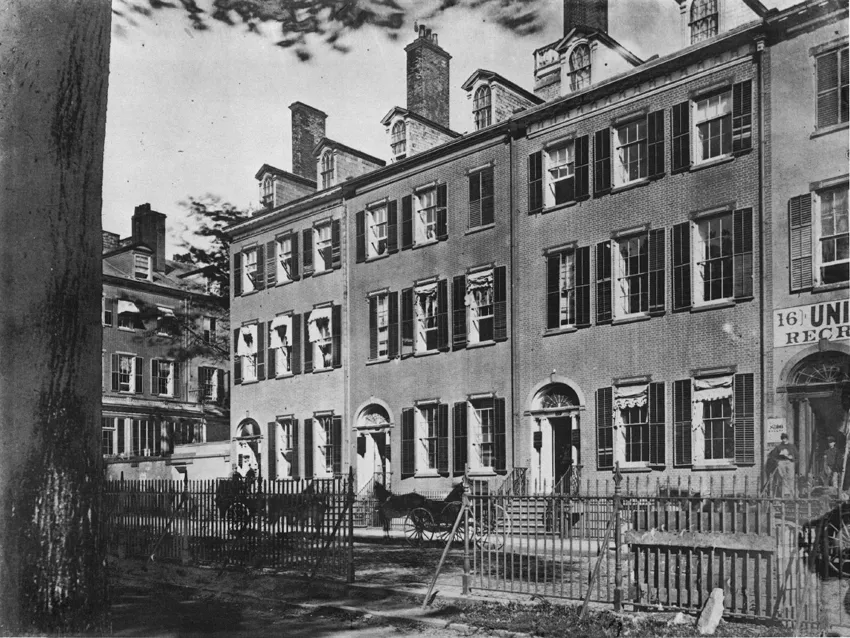
[PLATE 6]
State Street, c. 1864
State Street, c. 1864
A row of fine Federal houses facing Battery Park—on the west side of State Street just south of Bowling Green—is captured in this photograph of the Civil War period. A recruiting office is set up on the ground floor at No. 16, where a poster at the door offers a bounty of $800 to each enlistee. The other buildings are also in use as military offices.

[PLATE 7]
No. 7 State Street, c. 1888
No. 7 State Street, c. 1888
Facing Battery Park and planned to fit the curve of State Street is the Federal house built for James Watson in the early nineteenth century, supposedly from designs by John McComb, Jr. At the time of this view, the facade had been painted and the windows and doors highlighted in imitation of bold Georgian architectural detail, less in keeping with the elegance of the original house than its later restoration as part of the Shrine of Blessed Mother Seton. The horse-drawn street sprinkler is an independently important detail in this late nineteenth-century photograph of an early New York mansion that is still standing.
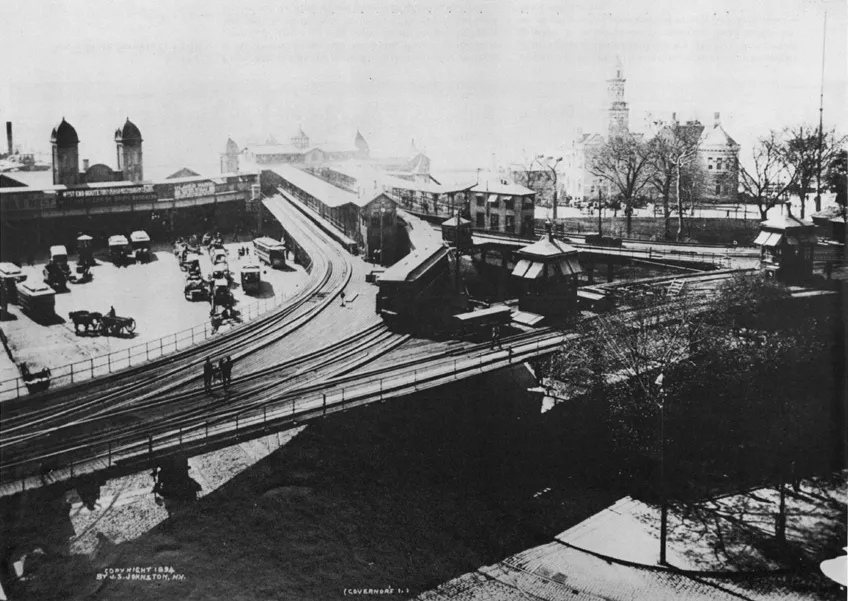
Photo, John S. Johnston
[PLATE 8]
South Ferry Y, 1894
South Ferry Y, 1894
The dramatic sweep of the South Ferry Y, which was the southern terminal of the el, is seen from Whitehall Street in this copyrighted print dated 1894. The Coney Island Ferry (in the slip at far left) took passengers direct to Buffalo Bill’s Wild West Show. At the far right is the turreted splendor of the Barge Office.
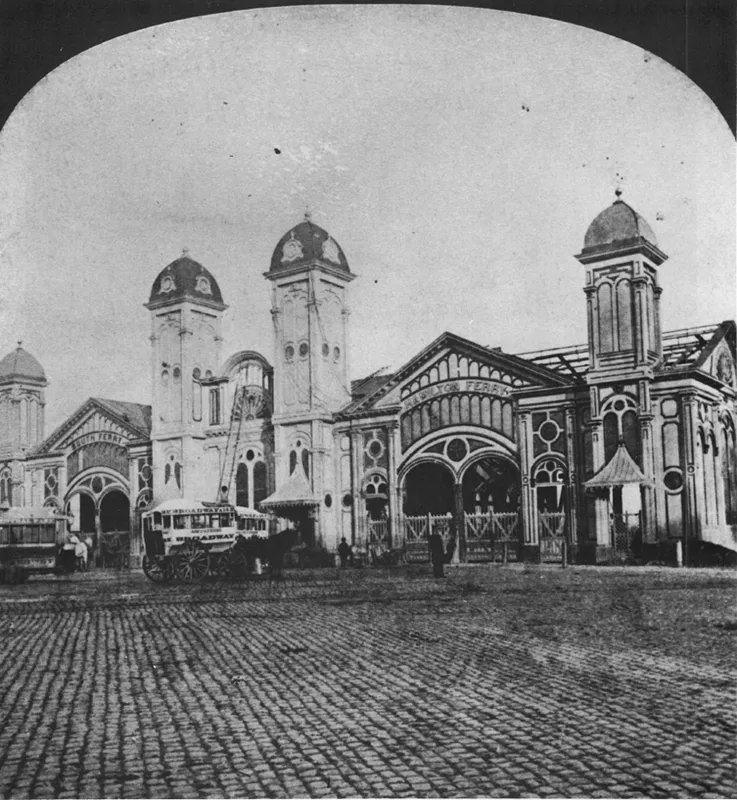
Stereograph, American Illustrated Company
[PLATE 9]
Brooklyn Ferry Stop, c. 1870
Brooklyn Ferry Stop, c. 1870
This ebullient Victor...
Table of contents
- Cover
- Title Page
- Copyright Page
- Contents
- List of Photographs
- I The Battery and the East River Waterfront (Nos. 1-24)
- II The Broadway Area North from Bowling Green to Duane Street and the Brooklyn Bridge (Nos. 25-54)
- III The West Side: Locations West of Trinity Place and North to Duane Street (Nos. 55-59)
- IV The West Side from Broadway West to the Hudson River and North from Duane Street to Barrow and Bleecker Streets (Nos.60-73)
- V The East Side from Broadway to the East River and North from Duane Street to Spring and Delancey Streets (Nos. 74-82)
- VI The East Side from Broadway to the East River and North from Spring and Delancey Streets to 14th Street (Nos. 83-93)
- VII The West Side from the Washington Square Area West to the Hudson River and North from Barrow and Bleecker Streets to 23rd Street (Nos. 94-102)
- VIII The Broadway Area from 14th Street to 23rd Street (Nos. 103-115)
- IX Broadway to the East River from 23rd Street to 40th Street (Nos.116-134)
- X The East Side from Fifth Avenue to the East River between 40th Street and 59th Street (Nos. 135-146)
- XI The West Side from Fifth Avenue to the Hudson River between 40th Street and 59th Street (Nos. 147-154)
- XII North in "The Territory" from 59th Street to Spuyten Duyvil(Nos. 155-191)
- Index of Identified Photographers
- Chronological Index of Photographs
- General Index